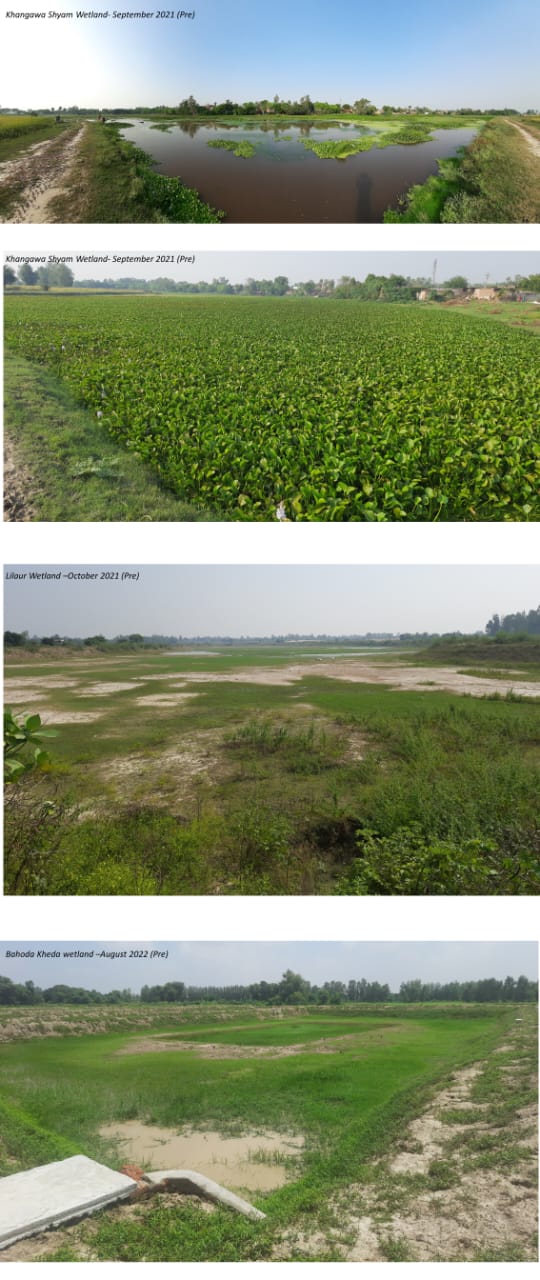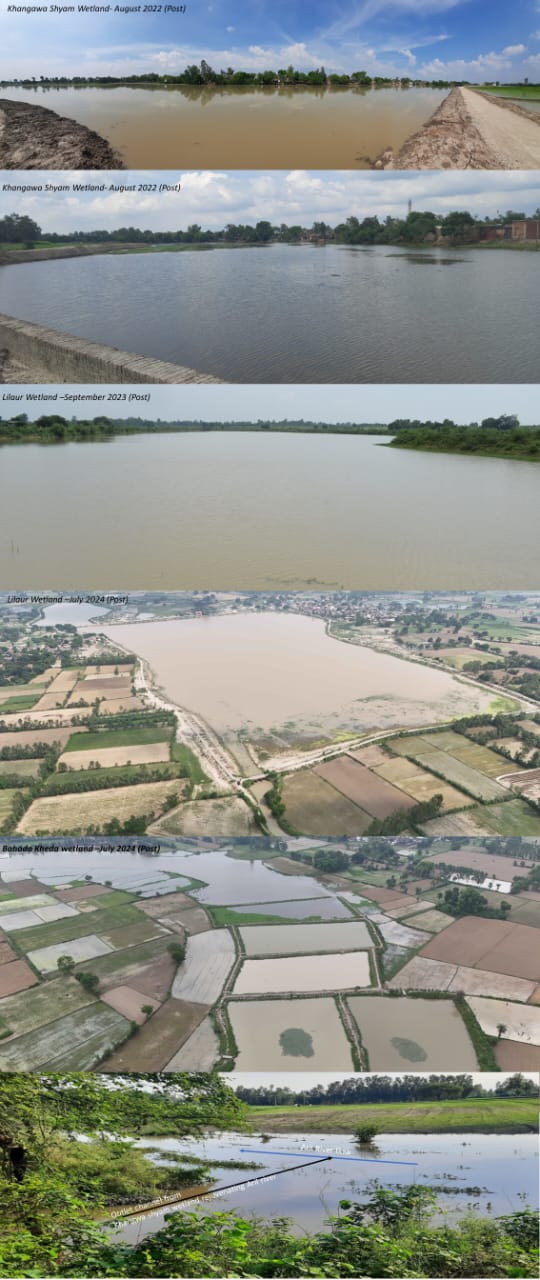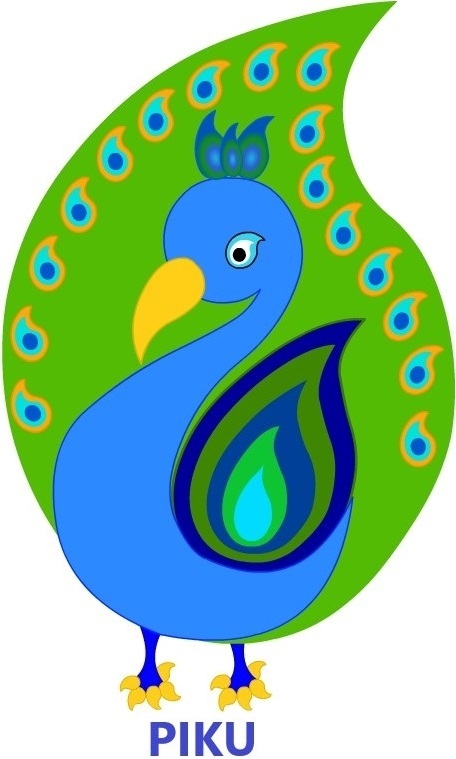Technical
1. WWF-India along with their technical partners (IIT-Kanpur and consultants) conducted a comprehensive assessment of wetlands in the Ramganga basin, including their degradation and groundwater conditions. This analysis led to the prioritization of wetlands for restoration. The Aril River basin was selected as a pilot project for demonstrating river-wetland co-management. A collaborative approach led by the district administration and coordinated by WWF-India has participation from various government departments, the District Ganga Committee, riparian communities and farmers. This joint initiative led to improvement in the ecological health of the river.
2. Spatio-temporal mapping of the Aril basin indicated that about 60% of wetlands were in a degraded state. Based on the wetland’s status and connectivity to river floodplains, 20 plus wetlands were field surveyed to collect baseline information which indicated that there are several major threats to the wetlands including excess weed growth, siltation, choked inlets/outlets, sewage inflow, fragmentation, intensive chemical usage in agriculture, LULC changes in the catchment, to ownerships.
3. Using a prioritization matrix three floodplain wetlands were selected viz. Khangawa Shyam (10.6 hectares (ha), Lilaur Lake (42 ha), and Bahoda Kheda (7.42 ha) in Bareilly district for taking up the restoration activities. These wetlands were prioritized based on their ecosystem services and biodiversity values/potential.
4. Topographic surveys of wetlands and their catchments were also conducted to map catchment characteristics (slope, siltation, volumes, etc)
Multi-Stakeholder Engagement
1. Comprehensive baseline surveys were conducted through engagement with riparian communities, and line departments to assess the existing status of the wetlands, including biodiversity, eco-hydrological health, ecosystem services, ownership, management regimes and threats.
2. A wetland restoration plan was co-developed through engagement and discussions with all key stakeholders, focusing on addressing threats such as degraded inlets/outlets, invasive weeds, catchment fragmentation, pollution, solid waste, and siltation.
3. A multi-stakeholder approach was adopted, involving the District Administration Bareilly, WWF-India, government departments, representatives from five villages, and over 500 community members under the ‘Aril Mitra platform to spread awareness and enhance community participation in restoration activities.
4. Community members were trained in sustainable agriculture practices to reduce negative impacts on wetland and river health through improved management practices, reduced chemical inputs, water usage, and adoption of organic inputs in agriculture. Mitras also contributed to restoration activities like channel rehabilitation, de-weeding, and wetland health monitoring.
Institutional and governance
1. The district administration and government departments provided essential administrative support for conservation activities. Synergies were established with government schemes like MNREGA to facilitate restoration efforts, such as desilting and channel rehabilitation.
2. Eight new inlets were created, and four inlet channels were rehabilitated to improve water flow from the catchment into the wetlands and Aril River. To enhance the ecological health of the wetlands, as a proof-of-concept, water hyacinth removal was conducted in a two-hectare area, where 2500 quintals of wet weed were removed. The deweeded invasives were converted into organic compost for use by local farmers. Several awareness and community mobilization activities were conducted to promote conservation efforts.
3. As part of impact assessment, the change in wetland’s hydrological and ecological health was monitored, where communities were also trained on monitoring of water quality, and groundwater levels as part of their empowerment through citizen science.
Ramganga (a tributary of Ganga River) and its tributaries are aquifer-fed river systems that are being subjected to loss of connectivity and degradation of river health (flows, water quality, biodiversity) due to over-abstraction of groundwater, diversion of surface water, unsustainable agriculture practices, pollution, land use change), encroachment etc. To improve river health, maintaining its 3-dimensional connectivity viz lateral (floodplain), Longitudinal (Upstream to downstream) and vertical (river-groundwater) connectivity is essential. Wetlands are an integral part of the river basin which helps in maintaining its eco-hydrological health. Apart from providing a myriad of ecosystem services to communities and biodiversity, wetlands are crucial in supporting base flows (lean season flows) in the river system through groundwater replenishment and direct connectivity through surface water channels.
Bareilly District Administration along with WWF-India and Aril River Mitras (friends of Aril) has adopted a unique approach to revive the Aril River (right bank tributary of Ramganga River) through river-wetland co-management. As part of this initiative, wetland restoration is done through multi-stakeholder engagement. The Bareilly District Administration and WWF-India have been able to mobilize collective action for wetland conservation by fostering partnerships among various entities, including MNREGA cell, government departments (Revenue, Groundwater, Minor irrigation, etc.), local communities, farmers and technical partners (IIT-Kanpur and consultants),. As part of this initiative, four wetlands with a collective area of over 62 hectares have been rejuvenated. This initiative is aligned with the NMCG’s vision of Aviral and Nirmal Ganga and contributes to the same.
Objectives of this initiative were:
• Demonstrate river rejuvenation through wetland restoration and monitoring of impacts
• Collective action on wetland restoration activities
• Multi-stakeholder engagement and capacity building of stakeholders on river and wetland rejuvenation
The impacts and benefits of this collective initiative are at multiple levels, including –
A. Improved Hydrological health of wetlands and enhanced resilience
• Increase in surface water inflows into the wetland- Post restoration, the three wetlands received additional inflows of 2.7 billion liters (270 crore liters) of additional water between 2022 and 2024) as compared to baseline condition. This not only improved the wetland's health and local water security but also rejuvenated the Aril River by discharging water from the wetland into the Aril River through a connected channel.
Khangawa Shyam wetland was rejuvenated by 225 million liters (22.5 crores) of additional water from the catchment
Lilaur Lake was rejuvenated by about 2300 million liters (230 crores) of additional water from the catchment due to restoration activities in contributing channels
Bahoda Kheda wetland was rejuvenated by an additional 180 million liters (18 crores) of water through new inlets created
B. Aril River rejuvenated through wetland restoration
• The health of the Aril River is enhanced, employing enhanced freshwater flows (to the tune of 200 million liters) in the river, through a connected outlet channel from the Khangawa Shyam wetland.
C. Improved Health of immediate catchment
• To improve wetland health and promote organic farming in the wetland zone of influence, 2500 quintals of wet weed were removed and turned into 700 quintals of compost, which is being used by farmers in their crops. The compost from hyacinth has 5 times more nitrogen, 10 times more phosphorus and 3 times more potassium in addition to high micronutrients.
• Apart from this, 500 plus farmers were trained on the preparation and adoption of bio-fertilizers and bio-pesticides (Amrit Paani and Amrit Khaad) and followed better management practices in agriculture through customized Package of Practices (PoP). Farmers reported an increase in the length of the wheat spike, improved plant health, saving of 1 watering in wheat crop, and a substantial reduction in chemical inputs, through the adoption of PoP.
• The increased water availability in wetlands led to an increase in groundwater levels by 4-5 feet thereby improving aquifer health and local water security for communities.
D. Effective Multi-Stakeholder engagement and governance
E. Several key stakeholders (District administration, line departments, riparian communities, farmers, experts, etc) were engaged, Synergies with government schemes like MNREGA were built and through leveraging of funds, 8 new inlets were created and 4 inlet channels were rehabilitated which brought more surface water inflows into wetlands. Improved habitats of aquatic and avian biodiversity
• The enhanced flows and removal of weeds in specific wetlands resulted in improved concentration of dissolved oxygen which increased from 4 mg/l to 6-8 mg/l.
The Improvement in wetland health provided conducive habitats for aquatic species (fishes and turtles) and dependent avian fauna.
This innovative approach tested river-wetland co-management in an aquifer-fed river system. River rejuvenation demonstrated the significance of wetland restoration in river catchments. The multi-stakeholder collaboration that led to the restoration of these wetlands is a distinguishing feature of this model, resulting in the successful rejuvenation of the Aril River. The initiative successfully integrated science, practice, and policy by adopting a whole government and multi-stakeholder approach to river rejuvenation.












